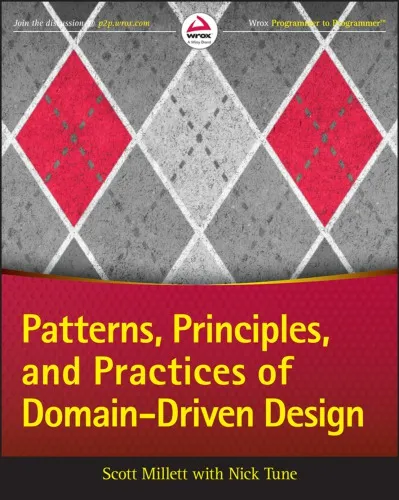Patterns, Principles, and Practices of Domain-Driven Design
4.5
بر اساس نظر کاربران

شما میتونید سوالاتتون در باره کتاب رو از هوش مصنوعیش بعد از ورود بپرسید
هر دانلود یا پرسش از هوش مصنوعی 2 امتیاز لازم دارد، برای بدست آوردن امتیاز رایگان، به صفحه ی راهنمای امتیازات سر بزنید و یک سری کار ارزشمند انجام بدینمعرفی کتاب "Patterns, Principles, and Practices of Domain-Driven Design"
کتاب "Patterns, Principles, and Practices of Domain-Driven Design" یک راهنمای جامع و عملی برای درک عمیق از اصول طراحی متمرکز بر دامنه (Domain-Driven Design) است. این کتاب توسط ما، اسکات میلت و نیک تیون، نوشته شده و هدف آن کمک به توسعهدهندگان نرمافزار، معماران سیستم و مهندسان طراحی است تا سیستمهای قدرتمند، کارآمد و مقیاسپذیر بسازند.
خلاصهای از کتاب
این کتاب شما را از مفاهیم بنیادی Domain-Driven Design (DDD) شروع کرده و در مراحل پیشرفتهتری همچون استفاده از Patterns و Strategic Design به شما کمک میکند. در آغاز، به درک اصول اصلی DDD، همچون استفاده مناسب از مدلسازی دامنه و ارتباط دادن آن با نیازهای تجاری، میپردازیم. سپس الگوهای رایج طراحی (Patterns) مانند Aggregate، Repository، و Value Object معرفی میشود.
علاوه بر اصول پایه، نگاه دقیقی به Best Practices مورد نیاز برای پیادهسازی DDD در پروژههای واقعی شده است. مباحثی نظیر مدیریت پیچیدگی نرمافزار، جداسازی Contextهای مختلف، و چگونگی کار با تیمهای توسعه توزیع شده در این کتاب توضیح داده شده است. همچنین به استفاده از ابزارهای مدرن نرمافزاری برای پیادهسازی موفقیتآمیز این اصول پرداخته میشود.
نکات کلیدی
- چگونه از منطق دامنه برای هماهنگی بین نیازهای تجاری و فناوری استفاده کنیم.
- توضیح دقیق الگوهای طراحی مانند Factory، Aggregate، و Repository.
- درک مفهوم Ubiquitous Language برای کاهش ابهام میان تیمهای چندتخصصه.
- معرفی Context Map و نقش آن در کاهش پیچیدگی سیستمهای بزرگ.
نقلقولهای معروف از کتاب
“A model is not just the knowledge in the developer's head, it is the sharpest useful concept of the domain that the team develops.”
“Strategic design is the art of organizing projects to ensure high alignment between the software system and the business requirements.”
چرا این کتاب اهمیت دارد؟
کتاب "Patterns, Principles, and Practices of Domain-Driven Design" نه تنها به اصول طراحی نرمافزار اشاره دارد، بلکه به شما نشان میدهد چگونه میتوانید این اصول را در پروژههای واقعی پیادهسازی کنید. در دورانی که نرمافزارهای مقیاسپذیر و دور از پیچیدگی برای هر کسبوکاری حیاتی است، این کتاب ابزارها و شیوههای لازم را برای موفقیت به شما ارائه میدهد.
چه یک مهندس باتجربه باشید که به دنبال بهبود مهارتهای خود است و چه یک تازهکار در حوزه طراحی نرمافزار، این کتاب مسیر روشنی برای ایجاد سیستمهای موثر و درک عمیقتر از طراحی نرمافزار پیش روی شما قرار میدهد.
Welcome to the introduction of Patterns, Principles, and Practices of Domain-Driven Design, a comprehensive guide authored by Millett, Scott, and Tune, Nick. This book serves as a strategic resource for anyone who wants to understand the essence of Domain-Driven Design (DDD) and how to apply it effectively in software development. By blending theory with practical examples, it helps developers, architects, and teams unlock the potential of creating software systems deeply connected to the problem domain.
Detailed Summary of the Book
The book provides a deep dive into Domain-Driven Design concepts while addressing patterns, principles, and best practices. It begins with the fundamentals of DDD, explaining its core philosophy: building software that mirrors the language and processes of its business domain. Moving beyond just theory, the authors explore practical strategies for breaking down complex systems using patterns like Bounded Contexts, Aggregates, and Domain Events.
In later chapters, the book tackles modern software development challenges like ensuring scalability, managing distributed systems, and designing for failure. Topics like Command Query Responsibility Segregation (CQRS) and Event Sourcing are covered with practical guidance, making them accessible for teams striving to build resilient systems. Throughout, the book bridges the gap between design techniques and implementation details by tying DDD principles to contemporary technologies such as cloud computing, NoSQL databases, and microservices architectures.
Finally, the book provides actionable advice on team collaboration and communication, key areas often overlooked in technical discussions. By focusing on communication between domain experts and developers, the authors ensure that the technical design stays aligned with business goals.
Key Takeaways
- Understand the Core of Domain-Driven Design: Learn to model complex business domains by capturing their intricacies with building blocks like Entities, Value Objects, and Repositories.
- Master Strategic Design: Discover how strategic tools like Bounded Contexts and Context Mapping guide the division of large domains into manageable subdomains.
- Explore Tactical DDD Patterns: Implement patterns like Aggregate Roots, Factories, and Domain Events for robust domain modeling.
- Improve Collaboration: Enhance teamwork between developers, domain experts, and stakeholders with tools like the ubiquitous language.
- Leverage Modern Architectures: Utilize DDD concepts in microservices, CQRS, Event Sourcing, and cloud-native software systems.
- Handle Complexity: Learn techniques to manage domain complexity and adapt to evolving business requirements.
Famous Quotes from the Book
Here are some memorable quotes from the book that distill its essence:
"The heart of software development lies in building a deep understanding between developers and the domain experts they work with."
"Bounded Contexts are a way to contain the inevitable complexity of large systems by drawing boundaries that align to the business."
"A model isn’t just a diagram; it’s a cohesive set of ideas that serve as the foundation for design and implementation."
Why This Book Matters
As industries increasingly adopt Domain-Driven Design, this book stands as a cornerstone for mastering the methodology. For professionals tackling complex software systems, it not only provides a rich theoretical foundation but also dives into modern, practical implementations. Whether you are building enterprise-grade solutions or microservices, the book equips you with the tools to create software systems that align with organizational goals.
Additionally, the book emphasizes the cultural and collaborative aspects of DDD, enabling developers and domain experts to speak the same language and work towards shared goals. It champions the idea that well-crafted software requires not just technical skill but also a deep connection to the business it supports.
In a world where software systems grow larger, more distributed, and increasingly complex, Patterns, Principles, and Practices of Domain-Driven Design provides a much-needed roadmap for developers and architects, ensuring that systems remain functional, maintainable, and rooted in real-world value.
The knowledge within these pages will serve as a guide for professionals aiming to bridge the gap between technical craftsmanship and business-driven solutions.
دانلود رایگان مستقیم
You Can Download this book after Login
دسترسی به کتابها از طریق پلتفرمهای قانونی و کتابخانههای عمومی نه تنها از حقوق نویسندگان و ناشران حمایت میکند، بلکه به پایداری فرهنگ کتابخوانی نیز کمک میرساند. پیش از دانلود، لحظهای به بررسی این گزینهها فکر کنید.
این کتاب رو در پلتفرم های دیگه ببینید
WorldCat به شما کمک میکنه تا کتاب ها رو در کتابخانه های سراسر دنیا پیدا کنید
امتیازها، نظرات تخصصی و صحبت ها درباره کتاب را در Goodreads ببینید
کتابهای کمیاب یا دست دوم را در AbeBooks پیدا کنید و بخرید
1118
بازدید4.5
امتیاز50
نظر98%
رضایتنظرات:
4.5
بر اساس 0 نظر کاربران
"کیفیت چاپ عالی بود، خیلی راضیام"


